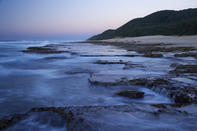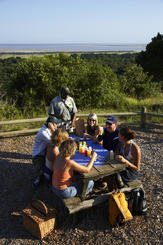Catalinas' First and Only Kill
Lake St Lucia, dawn, 20 August 1943, World War II. The sound of hippos grunting is drowned out by the cough of Pratt & Whitney engines. Two Catalina flying boats taxi across the mirrored lake into deeper water.

Flight-lieutenant Barnett gives a thumbs up and the engines roar as his great bird lumbers towards Mitchell Island. Eventually, the nose begins to lift and the aircraft soars into the sky before banking over the dunes and heading east. Now a second Catalina races across the water and lifts off to follow the leader into the rising sun.
These flying boats have been hunting U-boats for months, with no kills yet recorded. This morning their luck will change. U-197, flush from the success of torpedoing of the Swedish tanker Pegasus is cruising on the surface to the east of Richards Bay. In a few hours the Catalina's and the submarine have a meeting with destiny.
By the time Kapitän-Leutnant Bartels hears the sound of flying-boat engines, it’s too late to dive. He’ll have to fight the planes on the surface. His crew scrambles and soon the shell-firing guns have found their range. Catalina 126/C descends to wave-top height and flies straight into a hail of shrapnel. Barnett holds his nerve and drops all six depth charges with pinpoint accuracy. The U-boat tries to dive but the explosions have caused so much damage that it’s forced to surface again immediately.
Now the second aircraft presses home the attack. Barnett makes a strafing run to draw the U-boat’s fire, while Catalina N’s line of depth charges straddle the submarine. When the explosions subside, only oil and debris remain. The big white birds circle the spot then turn triumphantly for home. This will be the Catalinas’ first and only kill off the Zululand coast.
Mission Rocks

One of the most beautiful spots along the shore is Mission Rocks in Cape Vidal. There’s a picnic site, a beach and a line of serrated rocks pounded by surf. If you were an intrepid man of God and wanted to site your mission station in an elemental cauldron of your maker’s creating, this would be a pretty good spot to choose. Which is exactly what Norwegian Reverend LO Feyling did in 1898.
He was a poor man with few resources. But not long after he’d set up camp, fortune offered him a lucky break. The barque Dorothea was wrecked further up the coast and the reverend was able to salvage 20 tons of planking to build a solid mission house. He transported the wood all the way from the wreck site at Cape Vidal in a primitive wagon of his own construction which sported solid wheels cut from the trunks of enormous trees.
Feyling and his wife worked at Mission Rocks for 30 years before retiring to Durban. All that remains of their mission station are the foundations of the church, two baking ovens and two lonely graves. One of them marks the final resting place of Feyling’s brother Emil, who was taken by a crocodile while visiting in 1902.
By Justin Fox